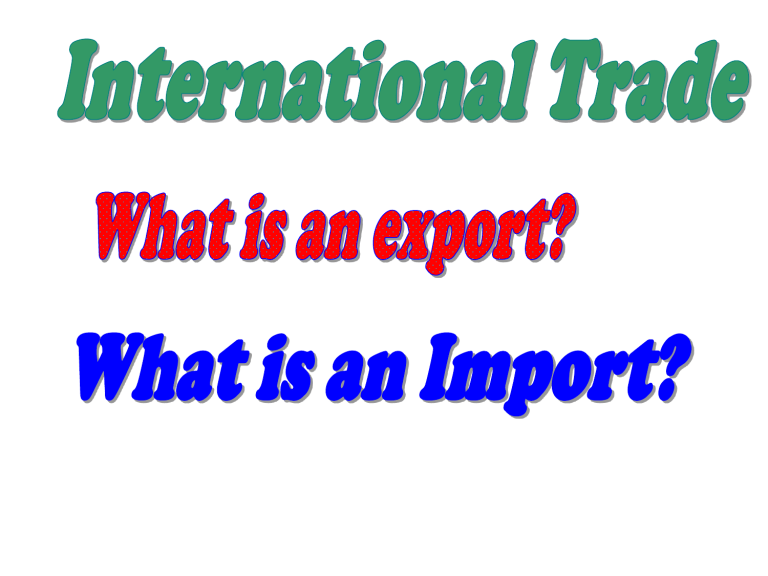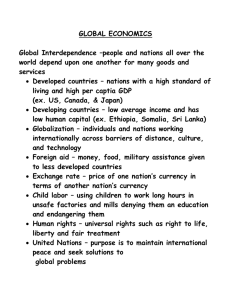Gaining from international trade

International Trade
The Trade Sector of the US
Growth:
- In 1975, exports and imports were each approximately 8% of the U.S. economy.
- In 2000, exports accounted for 11.2% of GDP and imports made up 14.9%.
Major Trading Partners:
- Canada, Mexico, and Japan
-China, Europe
International Trade Is of Increasing Importance to the US
U.S. International Trade in a World Context
International Trade as a Percentage of GDP
Leading Trading Partners of the U.S.
–––––––– Percent of Total U.S. Trade, 2002 ––––––––
–––––––– Percent of Total U.S. Trade, 2006 –––––
Canada
Mexico
–––
11.9%
19.8%
11.5%
China
Japan
9.1%
7.2%
11.9%
Germany
United Kingdom
South Korea
Taiwan
France
Malaysia
2.5%
4.9%
3.9%
3.1%
8.6%
4.5%
3.4%
2.7%
2.1%
2.3%
1.8%
2.1%
1.7%
34.4%
32.2% All other countries
• Today, Canada, Mexico, China, and Japan are the leading trading partners with the United States.
• The impact of international trade varies across industries. -
-some compete effectively, some do not.
Gains from
Specialization and Trade
Law of Comparative Advantage
• A group of individuals, regions, or nations can produce a larger joint output if each specializes in the production of goods in which it is a lowopportunity cost producer and trades for goods for which it is a high opportunity cost producer.
Gains from Specialization and Trade
• International trade allows each country to specialize according to the law of comparative advantage .
• Each country can produce those goods that it can produce at a low opportunity cost.
• Trading partners can consume a wider variety of goods than they could produce domestically.
Absolute advantage:
The ability to produce more of a good or service than competitors when using the same amount of resources.
Absolute advantage
Japan can produce more of both
Output per Hour of Work
Cell Phones Tablet Computers
Japan 12 6
United States 2 4
Comparative advantage
Japan is more efficient in producing cell phones
US is more efficient in producing tablets
Opportunity Costs
Cell Phones Tablet Computers
Japan 0.5 tablet computer 2 cell phones
United States 2 tablet computers 0.5 cell phone
Increasing Consumption through Trade
Terms of trade The ratio at which a country can trade its exports for imports from other countries.
Countries gain from specializing in producing goods in which they have a comparative advantage and trading for goods in which other countries have a comparative advantage.
Autarky A situation in which a country does not trade with other countries.
Why Don’t We See Complete Specialization?
1. Not all goods and services are traded internationally.
Some services are difficult to export, such as medical care.
2. Production of most goods involves increasing opportunity costs.
If a country devotes more workers to producing a good, the opportunity cost of producing more of that good will increase, causing the country to stop short of complete specialization.
3. Tastes for products differ.
Countries may each have a comparative advantage in producing different varieties of a particular product.
Does Anyone Lose as a Result of International Trade?
Some firms win, and some lose. The losers are likely to try to convince their governments to interfere by barring imports of the competing products from the other country or by imposing high tariffs on them.
Where Does Comparative Advantage Come From?
1. Climate and natural resources.
Geology can create comparative advantage.
2. Relative abundance of labor and capital.
Some countries have a comparative advantage in producing goods requiring highly skilled workers and sophisticated machinery, while others have a comparative advantage requiring unskilled workers and relatively simple machinery.
3. Technology.
Broadly defined, technology is the process firms use to turn inputs into goods and services.
Some countries are strong in product technologies, which involve the ability to develop new products.
Other countries are strong in process technologies, which involve the ability to improve the processes used to make existing products.
4. External economies. Once an industry becomes established in an area, firms that locate in that area gain advantages over firms located elsewhere.
Gains from Specialization and Trade
• International trade leads to gains from:
• Economies of Scale : reductions in per-unit costs that often accompany large-scale production, marketing, and distribution.
• More Competitive Markets :
Promotes competition in domestic markets and allows consumers to purchase a wide variety of goods at economical prices.
External economies: reductions in a firm’s costs that result from an increase in the size of an industry.
A Hard Lesson to Learn
Exports and Imports are Linked
• Exports provide the foreign exchange needed for the purchase of imports.
• Imports provide trading partners with the currency needed to purchase exported goods and services .
• Therefore, restrictions that limit one will also limit the other.
U.S. Has a Comparative Advantage
• The price of soybeans and other internationally traded commodities is determined by the forces of supply and demand in the world market.
• If U.S. soybean producers were prohibited from selling to foreigners, the domestic price would be P
• Free trade permits U.S. soybean producers to sell Q the higher world price of P w
.
n
.
p units at
U.S. Market
Price S d
World Market
Price
S w a b
P w
S w
P w
P n c
D d
Q c
Q n
Q p
Soybeans
(bushels) Q w
D w
Soybeans
(bushels)
U.S. Has a Comparative Advantage
• At the world price of P w
, the quantity (Q p
– Q c
) is exported.
• Compared to the no-trade situation, the producers’ gain from the higher price (P consumers (P w w b c P a c P n n
) exceeds the cost imposed on domestic
) by the triangle (area) a b c.
U.S. Market
Price
P w a b
S d
S w
P n c
D d
U.S. exports
Q c
Q n
Q p
Soybeans
(bushels)
World Market
Price
P w
Q w
S w
D w
Soybeans
(bushels)
•
• Consider the international market for manufacturing shoes.
In the absence of trade, the domestic price would be P n
.
• Since many foreign producers have a comparative advantage in the production of shoes, international trade leads to lower prices
P w
.
U.S. Market
Price S d
World Market
Price
S w
P n a
P w
D d
Shoes
Q n
Q w
D w
Shoes
• At the price P w
, U.S. consumers demand Q
) are imported.
c units of which
(Q c
– Q p
• Compared to no trade, consumers gain P n while domestic producers lose P
• A net gain of a b c results.
n a c P w
. a b P w
,
U.S. Market
Price S d
World Market
Price
S w
P n
P w b a c
D d
S w
U.S. imports
Q p
Q n
Q c
Shoes
P w
Q w
D w
Shoes
The Economics of
Trade Restrictions
Tariffs, Quotas and
Voluntary Export Restraints
Tariff A tax imposed by a government on imports.
Quota A numerical limit a government imposes on the quantity of a good that can be imported into the country.
Voluntary export restraint (VER) An agreement negotiated between two countries that places a numerical limit on the quantity of a good that can be imported by one country from the other country .
U.S. Tariff Rates: 1890 to the Present
–––––––– U.S. Average Tariff Rate ––––––––
(Duties collected as a share of dutiable imports)
60%
50%
40%
30%
20%
10%
1890 1910 1930 1950 1970 1990
4.5%
2006
Trade Restrictions: Impact of a Tariff.
• Consider a tariff on autos imports.
• Without a tariff, the world price of autos is P w
. At P w consumers
1 units …
Price
S
Domestic Q d1
Q
1 from U.S. producers and …
– Q d1 from foreign producers.
• A tariff t makes it more costly for
Americans to purchase autos from abroad. U.S. prices rise to P w and purchases fall from Q
1
+ t to Q
2
.
P w
+ t
Imports after tariff
• U.S. purchases from domestic producers rise from Q to Q d2 imports fall to Q
2
– Q d1 d2
.
…
• Producers gain area S … the tariff generates T tax revenues for the government… areas
U & V are deadweight losses from reduction in allocative efficiency.
P w
S
Q d1
U
Q d2
T V
Q
2
Q
1
Tariff = t
Initial imports
D
Domestic
Quantity
(automobiles)
Trade Restrictions: Impact of a Quota
• Consider a quota on peanuts.
• Without trade restraints, P the domestic price. At P
(the
world price of peanuts) would be
U.S. consumers would purchase Q
1
…
Price
S
Domestic
Q d1
Q
1 from U.S. producers and …
– Q d1 imported from abroad.
• A quota of Q
2
– Q d2 imports pushes the U.S. price up to P
2
. Import quota:
Q
2
– Q d2
• While total U.S. purchases fall
(from Q to Q producers rise (from Q and …
), those from U.S.
imports fall to Q d1
2 to Q
– Q d2 d2
)
.
P
2
P w
S U T V
Initial imports
• U.S. producers gain area S. Area
T goes to foreign producers with permits to import into the U.S.
D
Domestic
•U & V are deadweight losses.
Q d1
Q d2
Q
2
Q
1
Quantity
(peanuts)
Note: The government derives no additional revenue from quotas.
Price
Trade Restriction Impacts
S
Domestic
Price
S
Domestic
P w
+ t
P w
S U T V
Q d1
Q d2
Q
2
Q
1
Imports after tariff
P
2
Tariff = t
P w
Initial imports
D
Domestic
S
Quantity
(automobiles)
U T V
Import quota:
Q
2
– Q d2
Q d1
Q d2
Q
2
Q
1
Initial imports
D
Domestic
Quantity
(peanuts)
The Economic Effect of the U.S. Sugar Quota
Without quota, U.S. producers would sell 4.7 billion pounds of sugar,
U.S. consumers would buy 27.5 billion pounds, imports would have been 22.8 billion pounds
The U.S. price would be $0.28 per pound.
equilibrium would be at point E;
With sugar import quota of 5.3 billion pounds the price of sugar is $0.53 per pound,
U.S. producers supply 15.9 billion pounds.
U.S. consumers purchase 21.2 billion pounds
The Economic Effect of the U.S. Sugar Quota
The sugar quota causes a loss of consumer surplus equal to the area
A + B + C + D.
The area A is the gain to
U.S. sugar producers.
The area B is the gain to foreign sugar producers .
The areas C and D represent deadweight loss.
The total loss to U.S. consumers in 2010 was
$6.08 billion .
The High Cost of Preserving US Jobs with Tariffs and Quotas
Product
Benzenoid chemicals
Luggage
Softwood lumber
Dairy products
Frozen orange juice
Ball bearings
Machine tools
Women's handbags
Canned tuna
Number of Jobs
Saved
216
226
605
2,378
609
146
1,556
773
390
Cost to Consumers per Year for Each Job Saved
$1,376,435
1,285,078
1,044,271
685,323
635,103
603,368
479,452
263,535
257,640
Practical Application:
In 2002, the Bush administration imposed tariffs of up to 25% on imported steel products. This action a.reduced the supply of steel in the domestic market and led to higher steel prices.
b.increased U.S. employment because it saved jobs in the steel industry. c. reduced employment in the U.S. steel container industry because the higher steel prices made it more difficult for them to compete with foreign rivals.
Preserving Japanese Jobs with Tariffs and
Quotas Is Also Expensive
Product
Rice
Natural gas
Gasoline
Paper
Beef, pork, and poultry
Cosmetics
Radio and television sets
Cost to Consumers per
Year for Each Job Saved
$51,233,000
27,987,000
6,329,000
3,813,000
1,933,000
1,778,000
915,000
Why do Nations Adopt
Trade Restrictions?
1.
National Defense argument
2.
Protect higher wages argument
3.
Saves domestic employment
4.
Prevents Dumping : a. The sale of goods abroad at a price below cost b. Allows foreign f irms to achieve economies of scale.
c. Foreign firms may want to gain entry to another market. Sell below cost to gain sales.
5 . Infant Industry argument a. Protect developing industries while growing b. Difficult to tell when they are adult.
Efforts to Reduce Trade Restrictions
GATT / WTO
In 1948 the United States and Europe set up the General Agreement on Tariffs and Trade (GATT) to reduce tariffs and revive international trade after World War II
A series of multilateral negotiations, called trade rounds, took place, in which countries agreed to reduce tariffs from the very high levels of the 1930s.
In the following decades, trade in services and in products incorporating intellectual property, such as software programs and movies, grew in importance.
Efforts to Reduce Trade Restrictions
GATT / WTO
In January 1995, GATT was replaced by the World Trade
Organization (WTO).
World Trade Organization (WTO) An international organization that oversees international trade agreements.
Why Do Some People Oppose the World Trade Organization?
1.
Some opponents are specifically against the globalization process that began in the 1980s and became widespread in the 1990s.
2.
Other opponents have the same motivation as the supporters of tariffs in the 1930s—to erect trade barriers to protect domestic firms from foreign competition.
3.
Some critics of the WTO support globalization in principle but believe that the WTO favors the interests of the high-income countries at the expense of the low-income countries.
Globalization The process of countries becoming more open to foreign trade and investment.
Anti-Globalization Many of those who protest at WTO meetings distrust globalization.
Some believe that free trade and foreign investment destroy the distinctive cultures of those countries.
Globalization has also allowed multinational corporations to relocate factories from high-income countries to low-income countries.
Some people have argued that firms with factories in developing countries should pay workers wages as high as those paid in highincome countries, abiding by the same health, safety, and environmental regulations.
The governments of most developing countries have arguments against these proposals.
IMF -
loans and financial assistance
EU -
European free trade area
NAFTA -
North American free trade area
U.S. Trade with Canada and Mexico
3%
2%
1%
6%
5%
–––––––– U.S. Trade with Canada and Mexico ––––––
––
(Exports and Imports together as a share of GDP)
Canada
4%
Mexico
1980 1985 1990 1995 2000 2005
• U.S. trade with both Canada and Mexico grew rapidly following the passage of NAFTA.
Trade Fallacies
• Trade fallacies abound because people often fail to consider the secondary effects.
• Key elements of international trade are often linked – you cannot change one element without changing the other.
• This is the case with imports and exports; policies that restrain imports also restrain exports.
Trade Fallacies
• Trade fallacy 1:
“Trade restrictions that limit imports save jobs for Americans.”
• This view is false because if foreigners sell less to us they will have fewer dollars with which to buy things from us.
• Trade restrictions do not “save” jobs; they merely reshuffle them. Jobs “saved” in protected industries will be offset by jobs “lost” in export industries.
• As the result of trade restrictions, fewer Americans are employed in areas where we have a comparative advantage.
Trade Fallacies
• Trade fallacy 2:
"Free trade with low-wage countries, such as
Mexico and China, will reduce the wages of
Americans."
• Both high- and low-wage countries will gain when they are able to focus more of their resources on those productive activities that they do well.
• The key to this issue is how will U.S. resources be used. If a low-wage country can supply a good cheaper than we can produce it, the U.S. can gain by purchasing the good from the low-wage country and using its resources to produce other goods for which it has a comparative advantage.
1. Measured as a share of the economy, the size of the trade sector (exports plus imports) of the United States has a. been increasing since 1980, but it declined during 1960–
1980.
b.been relatively constant during the last four decades .
c. increased by about 10 percent during the last four decades.
d.approximately doubled since 1980 and tripled since 1960.
2. A U.S. trade policy that restricts the sale of foreign goods in the U.S. market will a. reduce the demand for U.S. export goods since foreigners will be less able to buy our goods if they cannot sell to us.
b.benefit producers in industries that export goods.
c. increase the nation’s income since it protects domestic jobs.
d.enhance economic efficiency by allocating more resources to the areas of their greatest comparative advantage.
True or
False
1.
The purchase of goods and services from abroad is called exporting.
2.
The largest category of U.S. exports is foods and beverages.
3.
The country with which the United States carries on the largest amount of international trade is Canada.
4.
The scarcity problem can be eliminated by increasing production through specialization.
5.
A country is said to have a comparative advantage over another country if it can produce a product at a lower opportunity cost than can the other country
6.
The availability of appropriate markets and the ability to trade are necessary if countries are to specialize in their production
7.
Trade restrictions must be imposed between countries if they are to gain the full benefits of production according to comparative advantage.
8.
A total ban on imports from another country is a quota.
9.
A tariff is a restriction on the quantity of a product that can enter a country.
10.
The complete prohibition of trade in a particular commodity with a particular nation is called an embargo
11.
The prices and availabilities of goods and services should be lower with free trade than with restricted trade
12.
One of the protectionist arguments is that trade restrictions should be imposed to ensure national security
13.
The sale of a product in a foreign market at a price below cost is called dumping
14.
Negotiations under the General Agreement on Tariffs and Trade have resulted in lower tariffs between nations.



![Quiz About [Your Topic]](http://s3.studylib.net/store/data/009237721_1-467865351cf76015d6a722694bb95331-300x300.png)


